 Download
in PDF Format
Download
in PDF Format
�Down Home In The Orange"
Sandwiched
in an area of high growth, this traditional community's motto is
"sweet living, steady progress."
It doesn�t take too long to realize that
Orange is a traditional town, representative of a time when life was
simpler, people were nicer and everyone spoke to you, whether they knew you
or not.
|
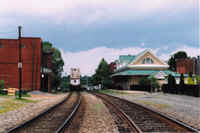
A
northbound freight train heads out of town past the Orange Train
Station and across Main Street. |
A traditional Main Street community,
Orange is a town steeped in history with the unique ability to serve up a
steaming cup of nostalgia as well. Sure, the stoplights are modern, the
traffic through the town�s primary intersection can be troublesome, and
there�s a big green coffee cup that lights up the night over a popular
eatery, but Orange is definitely a town that offers a glimpse into the past
from a 21st-century window.
Orange originated as and remains a
courthouse town. When the county was formed in 1734, it stretched from its
present eastern boundary 15 miles west of Fredericksburg infinitely west to
the Mississippi River and north to the Great Lakes. A county now 342 square
miles once included the states of Ohio, Illinois, Indiana, Kentucky and West
Virginia. The town became the county�s judicial seat in 1749, when
Culpeper County carved itself from Orange, leaving the courthouse location
of Raccoon Ford far from the center of the county.
Orange has enjoyed a front-row seat on
American history, watching a British raid on nearby Antioch Church and
Lafayette�s march through the county during the American Revolution, and
viewing countless Civil War battles, including the nearby Mine Run campaign
and Wilderness battles. General Robert E. Lee and many of his staff
worshiped at historic St. Thomas� Episcopal Church in town and a cavalry
battle took to the town�s streets in 1862.
|

Looking
east on Main Street. |
Just minutes from town lived James
Madison, the fourth U.S. president. And 12th President Zachary Taylor was
born 15 miles from Orange. Colonial governor Alexander Spotswood and state
governors James Barbour, James Kemper and J. Lindsay Almond all have called
Orange County home.
Orange is a town defined by its history
and much of that history is defined by the town�s location. These
ingredients marinate the town with a desirable appeal and a traditional feel
that make it both a great place to visit and an enjoyable place to live.
�Orange is a well-kept secret,�
Jimmy
Darnell says, sort of hoping that secret doesn�t
|
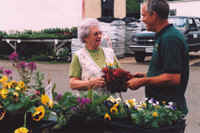
Jimmy
Darnell assists Louise Colvin at his nursery, The Garden Patch. |
get out too much. Darnell
runs a nursery in town and has lived in Orange most of his life. �It�s
safe and quiet and has most everything we need. We�re really lucky.
We�re between these areas of such high growth. And I don�t envy that.
But we have a good quality of life. It�s peaceful.�
The Heat Is On
Development pressures Orange from nearly
every direction. To the east, Fredericksburg and Spotsylvania County creep
ever closer to Orange County�s tranquility along Route 3 West. To the
north, Culpeper County is burgeoning with a Northern Virginia workforce that
is moving ever further south. To Orange�s west, Charlottesville and
Albemarle County residents retreat from their growth toward the peaceful
borders of the county.
Darnell�s well-kept secret is getting
out.
In a town of just more than 4,100 people,
Orange is recognized for its slower pace and simple lifestyle. The town�s
motto is even �sweet living, steady progress.� Nothing fancy. Not too
much progress, but just enough.
That progress is immediately apparent at
the town�s primary intersection of Main Street and Madison Road. Heavy
earthmoving and construction equipment renovates the town�s 1865
Italianate courthouse. Across town, a new middle school is under
construction and is halfway completed. Downtown, a new bakery and jewelry
store have opened and a popular dance studio, the Orange School for
Performing Arts, is turning the town�s original fire station into a
community theater.
|
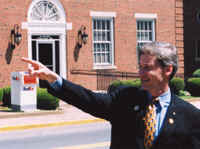
Orange
Downtown Alliance Director Jay Harrison looks west on Main Street. |
An Eye Toward the Future
�This is a town that�s interested in
its future,� Orange Downtown Alliance Executive Director Jay Harrison
notes. �The town is traditional, but not complacent.�
Even with all the growth and development
pressures from neighboring communities, Orange still manages to provide that
simple lifestyle and quality of life its residents expect.
|
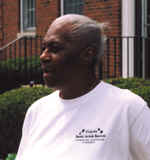
June
Robinson, a local rescue squad volunteer, looks across Main Street. |
�People are still so friendly,�
June
Robinson explains. Robinson, a long-time resident, also volunteers with the
local rescue squad. �People don�t even know each other and they speak.
It�s definitely a southern, country town.�
Letitia Franklin agrees. She taught school
for more than 30 years and spends much of her time now in community service.
�This is a nice, quiet and aesthetic
community. It�s respectful of its heritage and traditions,� she says.
�It�s a good community to live and raise a family in and retire in.�
|
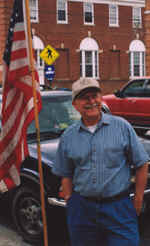
Mayor
Ray Lonick looks upward toward the historic Sparks building in town. |
�This is a town that gives people a
sense of �neighborhood,� � Mayor Ray Lonick adds. �Across America,
downtowns and neighborhoods disappear and people grow impersonal. But Orange
has a core � the downtown � and that brings people into town and helps
them get to know and recognize a lot of people.�
In fact, many of the town�s amenities
are within an easy morning walk. The post office and one of half-a-dozen
banks are at the west end of the street. Behind the post office are the
town�s offices. The old courthouse presides over the middle of town,
across from the county offices. Divided by Route 15, the east end of Main
Street features a restored early 20th-century train station (that serves as
the county�s visitors bureau) and the dynamic Arts Center in Orange.
Anchored in the Arts
Harrison notes the town is anchored on
either end with fine-arts establishments � the dance studio on the
town�s west end, the arts center, with its regular shows and instructional
courses, at the other.
A short walk north on Madison Road opens
the door to a variety of eating establishments, the library and the
requisite small-town businesses and shops.
�I like walking down the street and
going into the hardware store and not just asking where I can find
something, but having someone take me to it and find it,� Lonick notes.
�You find that in a small town like Orange.�
It�s that small-town, down-home feel
that draws thousands of people to Orange annually. Tourism director Karon
Keith says Orange offers visitors a sort of nostalgia, where they can enjoy
modern conveniences in a setting reminiscent of the town of their childhood.
�Many people come to visit from Northern
Virginia to get away from the hustle and bustle of a bigger town,� Keith
explains. �They like the tranquility. They like the pace. Sometimes, they
like to come and just do nothing but relax.�
Orange can appeal to whatever taste a
traveler has. If they�re interested in history, they�ve come to the
right place. Within town, there�s a historic-building walking tour and the
James Madison Museum. Five minutes west on Route 20 is the historic
Montpelier estate, home to James Madison. A 15-minute drive to Gordonsville
brings travelers to the Gordonsville Civil War Museum at the Exchange Hotel,
a former Civil War receiving hospital. A 20-minute drive east on Route 20
reveals the rolling countryside of the Wilderness Civil War battlefield.
If a traveler is interested in the arts,
there are the aforementioned studios in town as well as a prominent,
nationally known sculptor who lives and works on Main Street. Other art
galleries are only a 15-minute drive from town.
An Ideal Location
Additionally, Orange County is the
state�s second-largest producer of grapes and two nationally recognized
wineries are available for tastings and tours just up the road in
Barboursville. �Orange is in the middle of a lot of things,� Mayor
Lonick notes. �People can do anything they want to do or go anywhere they
want to go � except the ocean � within an hour or an hour and a half.
This is the ideal location.�
But for those who get to town and stay in
one of five bed-and-breakfasts or its new award-winning hotel, there�s
plenty to do and see in town as well. A morning cup of coffee at Not the
Same Old Grind is always a good way to start the day. Enjoying a fresh
pastry or muffin from the nearby Downtown Bakery is a good compliment to
that cup of coffee. The James Madison Museum is just a short walk away,
where an exhibit currently highlights the accomplishments of women on the
farm in this agriculturally based community. Nearby, enjoy a hamburger at
Jean�s Caf� or ride over to the Dairy Korner for a lunch special. If
it�s Tuesday, get the chicken fried steak special with the white gravy.
Green or butter beans and mashed potatoes with gravy come with it. Spend the
rest of the afternoon antiquing or working off lunch by taking the town�s
walking tour. If it�s Saturday, stop by the Orange Farmers� Market for
fresh vegetables, baked goods or handmade crafts from local vendors.
�Orange may be a simple town,� Keith
notes, �but it sure isn�t boring.�